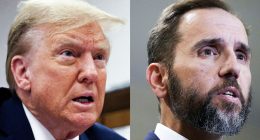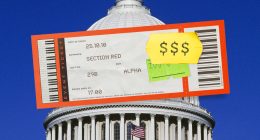
It’s a familiar litany by now: As Covid-19 spread, ravaged lives, and upended the global economy over the last two months, President Donald Trump first downplayed the virus—assuring Americans that it was going to go away—then chalked it all up as a complete surprise. On January 22, at the World Economic Forum in Davos, it was all business as usual. He promised CNBC’s Joe Kernan there were no worries about a pandemic: “We have it totally under control. It’s one person coming in from China, and we have it under control. It’s going to be just fine.”
A month later, Trump’s message was the same. “It’s going to disappear,” Trump said of the coronavirus on February 27. “One day—it’s like a miracle—it will disappear.” Then, as it became clear the virus wasn’t going away, Trump has instead tried to avoid blame, arguing that the novel coronavirus pandemic is a Black Swan, an unimaginable, surprise, out-of-left-field event. “This was unexpected,” he said on March 10. “It hit the world.” On March 16, Trump said, “This came up—it came up so suddenly. Look, he was surprised; we were all surprised.” And on March 24, he told a Fox News town hall, “Nobody ever expected a thing like this.”
Except it was expected. Over the last quarter century, warnings have been clear and consistent from both US government leaders, scientists, and global health officials: A pandemic was coming—and whenever it arrived, it would be catastrophic to the global economy. In recent years red alerts have come almost monthly—sometimes weekly—and all three of Trump’s predecessors have dedicated significant personal time and public attention to the pandemic threat.
The most recent warning, a bipartisan report by the Center for Strategic and International Studies, co-chaired by former New Hampshire Senator Kelly Ayotte, a Republican, and Julie Gerberding, George W. Bush’s one-time director for the Centers for Disease Control and Prevention, was published on November 18, 2019—one day after we now know the first case of the novel coronavirus that would be later named SARS-CoV-2 appeared in China’s Hubei Province. That report’s No. 1 recommendation was to undo the Trump administration’s cuts to pandemic planning: “Restore health security leadership at the White House National Security Council.”
A careful review of past reports, books, planning documents, Congressional hearings, op-eds, speeches, and public testimonies make clear that all the problems of the current Covid-19 crisis were foreseen over the last 15 years, as officials and leaders like Bill Gates warned in increasingly dire terms about the government’s lack of sufficient preparation.
As early as 2005, President Bush said, “Our country has been given fair warning of this danger to our homeland.” Eight years ago, a report by the US Department of Health and Human Services cited the need to develop “social distancing” models to inform how we combat the spread of a pandemic; it also pointed to potentially dangerous shortfalls in ventilator stockpiles and noted that there were local shortages of masks during the H1N1 pandemic, though these were filled by the national stockpile equipment. Repeated public warnings came even from those on the frontline of today’s response, including Health and Human Services Secretary Alex Azar and Anthony Fauci, the longtime head of the National Institute of Allergy and Infectious Diseases.
Despite substantial progress during the Obama administration—which grappled with the H1N1 scare and the 2014 Ebola outbreak and which was so concerned about the threat of a pandemic that it even highlighted the threat in a tabletop exercise with incoming officials during the transition—the Trump administration let pandemic planning efforts lapse.
That trend, too, was clear early. As early as seven weeks into the Trump administration, a group of Democratic lawmakers, including Massachusets Senator Elizabeth Warren, were raising concerns that the Trump administration was undermining pandemic preparedness efforts. As she and four other members of Congress wrote to then-Health and Human Services Secretary Tom Price, “Actions taken by President Trump could also impair our readiness in the face of a public health crisis, such as a flu pandemic.”
The truth is, it isn’t just the Trump administration that failed to sufficiently heed the tsunami of warnings. Leaders in state and local government, industry, and multinational institutions—all of whom share the responsibility to be prepared—were equally on notice that a pandemic was coming. But in the United States, we look to the federal government to lead the efforts on problems too big and too complex for any one jurisdiction or company.
The following oral history of public pandemic warnings has been compiled from government and other official reports, medical journals, videos, books, op-eds, Congressional hearings, news articles, statements, and other public records. None of the following quotations are backward-looking “I told you so’s”; all are contemporaneous, forward-looking warnings and predictions. None was classified; all but one was publicly released and available for all to read. The one document not released to the public: A National Security Council pandemic playbook reportedly written by the Obama administration in 2016 and passed off to the Trump administration in 2017.
Editor’s Note: If you’d like to read previous installments of our Covid Spring series, Chapter 1 dealt with patients and those on the front lines of the response across the country. Chapter 2 featured the voices of eight Americans who have watched what would normally be some of the biggest and most quintessentially human moments in their lives—births, weddings, loved ones’ deaths—remade and altered forever by the virus’s shadow. Chapter 3 featured the voices of New Yorkers at the center of America’s Covid-19 epidemic. Last week’s Chapter 4 featured Jewish and Christian faith leaders about Passover and Easter in a time of anxiety and quarantine. Also, for ease of reading, certain acronyms in the quotations below have been written out.
I. The Clinton Era
Laurie Garrett, The Coming Plague: Newly Emerging Diseases in a World Out of Balance, October 1, 1994: Many aspects of history are unanticipated and unforeseen, predictable only in retrospect: the fall of the Berlin Wall is a single recent example. Yet in one vital area, the emergence and spread of new infectious diseases, we can already predict the future—and it is threatening and dangerous to us all.
White House Press Release, June 12, 1996: Calling emerging infectious diseases a growing global health threat, Vice President Gore today announced President Clinton’s new policy to establish a worldwide infectious disease surveillance and response system and expand certain federal agency mandates to better protect American citizens. “Emerging infectious diseases present one of the most significant health and security challenges facing the global community,” Vice President Gore said during remarks to the annual meeting of the National Council for International Health in Crystal City, Virginia. “Through President Clinton’s leadership, we now have the first national policy to deal with this serious international problem.”
II.The Bush Era
Gardiner Harris, “From Washington, a Story About a Killer Flu,” The New York Times, October 16, 2005: This week, the Bush administration is expected to release its pandemic flu plan, which could generate its own movie epic. The New York Times obtained a draft of the plan, dated September 30. No one would confuse the 381-page document with a screenplay, but pages 45 through 47, the section titled “Pandemic Scenario—Origin and Initial Spread,” are gripping. They describe a flu epidemic moving from a village in Asia to the United States, where it causes panic and as many as 1.9 million deaths.









